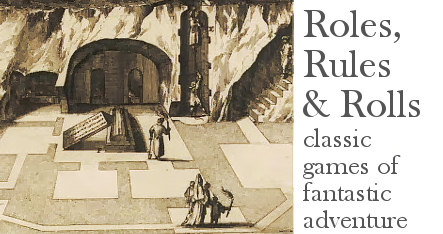So. I'm back.
Visiting
Paolo up in the northern lands, we went to the excellent game shop
Static on King Street and browsed its second-hand trove. I came away with two third-party products from the glory days of my first encounters with D&D, the early 80's days of electric-typewriter-and-Letraset layout, amateur art, and occasional gemstones of creativity amid the dross of naive simulationism. Paolo added thereto a third item from his collection. In the next few posts, I'll now review and muse upon these items in ascending order of interest value.
First up: WITHIN THE TYRANT'S DEMESNE, "a complete campaign module set in the world of Haven." The stats are from the "
Thieves' Guild" game but very similar to the levels and abilities of D&D or its then-numerous improved systems. The authors don't get cover billing, but it's a collaboration among four names, chiefly Walter Hunt and Richard Meyer. The artists include -- is that Jeff Dee? no, the similarly cartoon-deco-styled V. M. Wyman (are those
sci-fi lady initials?), and some other less talented names.
Overall: A standard fantasy city where the intrigues are predictable.
Cons: The kind of gazetteer-style design Zak's
Vornheim reacted against. We start with a regional map and history, call out the factions and describe in detail each of their characters, go for a "tour" around the city neighborhoods, involving more building, shop and character descriptions, and finally -- in a 48-page book -- get down to six pages of plots and encounters that deploy what we've seen.
There's very little bizarre about the place, even in its weirdness. There's a tyrant, who keeps power through his brutal guards, the unfortunately named Redshirts, and also through a coopted thieves' guild. There's a merchant society, a bunch of wizard guilds. Reading about the other characters, it doesn't feel much like a tyranny is going on. Political allegiances of most shopkeepers are down to a random table. Explicit descriptions of oppression, resistance, toadying, plotting, and cowardice are few and far between. Probably the most memorable encounter hook is a bunch of blobby chaos creatures who bring back human meat for a butcher, Sweeney Todd style.
Awful wordplay abounds, like the gang modeled after The Who with a "Dr. Jimmy," a "Quiet One," etc.; the potion seller Plazebo; throwing in some obscure US labor movement references, a wizard called Ilgwu who is involved in a plot with the resistance leader Johill. But ...
Pro 1: In a fantasy world filled with Butars, Adars, Radmars, Bonams, Corams, and the occasional Lobar (all from the Tyrant's Demesne, mind you), it can be hard to get names straight. Yes, awful puns can help the DM remember who's who.
BUT, the players must get the puns only too late, or never. So Plazebo is too obvious; the Who goons could be just under the radar. Likewise the most clever name in the module, a lockpicker named Kasserine Khyber, after two famous mountain passes from military history. I once had a party do a whole campaign where Rick, son of Nick lived in a millhouse with a water gate near the Ford of Jerrold and was being investigated by the Wood Warden Burnsteen from the rangers' Post... Thankfully, they never got it until I revealed the scheme.
Pro 2: The intrigues, when actually described, are decent spots of mystery. There's a fairly linear plot to follow and discover a traitor to the Tyrant; a more multi-threaded plot involving apparitions of the apparently dead Johill, with a Scooby Doo-type explanation; and a number of short encounters that highlight some of the other secrets of the town. They're just hiding behind long stretches of description that follow neither the logical order of player engagement with the setting, nor the order of GM preparation to run any given adventure. The helpful table of NPC stats in the back can't mitigate this.
To do better in a modern-day roleplaying work, we have to realize what the city is, functionally, for the players and their characters. And that's the next post.






/pic529002.jpg)





